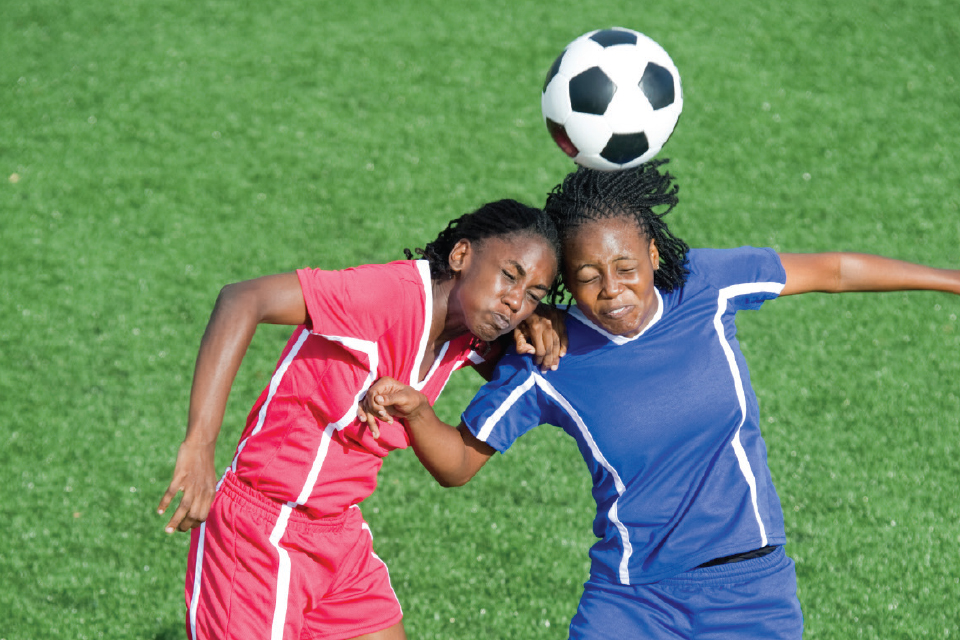Let's Talk Soccer Injuries

This article focuses specifically on two injuries that occur in soccer players and how to avoid these injuries: ACL tears and concussions, serious injuries that can be prevented to some degree.
ACL Tears
The ACL (anterior cruciate ligament) is an important ligament in the knee that provides stability in cutting motion or changing direction quickly, as is done in soccer and similar sports. The ligament is vulnerable during these types of motions. Though both men and women can suffer from this injury, women are more vulnerable. It is thought that hormone changes and differences in sport maturity, training technique, and strength and coordination might make women more vulnerable. It then makes sense that preventative strength and conditioning programs can help prevent these injuries. There are ACL prevention programs that significantly lower the risk of an ACL tear and, as an added bonus, usually also help improve performance. These programs focus on proper technique and using all appropriate muscle groups and joints together in a coordinated way to prevent stress to the ACL. An ACL injury is usually a season-ending injury, but by enrolling in an ACL prevention program, athletes and their teams will have a lower risk of injury and, therefore, a more productive season.
Concussions in Soccer Players
Concussions are the mildest form of head injury and yet can still cause significant health issues. Luckily, if treated properly, a concussion typically resolves without any future associated difficulty. If not treated properly, or if numerous concussions occur in the same athlete, there can be lifelong consequences. Studies have recently noted a significantly higher risk of concussion in female athletes, and one of the most popular sports in which a woman can get a concussion is soccer.
There are a few incidents that can cause concussion while playing soccer. One is colliding with another player. Soccer is a collision sport; people get tackled, run into each other, and bump heads. Any of these types of collisions could cause injury, even if the head itself isn’t hit. That is right; players don’t have to hit their head to get a concussion! If, after a collision, an athlete has a headache or doesn’t feel quite right in the head, likely she has sustained a concussion.
Another common way soccer players can sustain a concussion is by heading the ball. Using the head as an extremity to create ball directional changes makes the head vulnerable to injury. In the past, heading the ball was not thought to contribute to concussions, but it is now known to be otherwise. Repeatedly heading the ball increases the risk for injury and severity of injury. Just as in a collision, if, after heading the ball, an athlete has a headache or doesn’t feel quite right in the head, he has likely sustained a concussion. This might happen on the first header of the game, or only after repeatedly heading the ball throughout the day. Recent studies have shown that concentration and memory problems occur more commonly in soccer players who head the ball often as compared to others who do not.
How can players avoid getting a concussion from heading the ball? Strengthening neck muscles will help but won’t entirely eliminate the injury risk. Using a properly sized soccer ball in youth can also help to avoid the impact of a heavier ball. And training in proper technique will help.
I want to mention headgear because it doesn’t actually prevent concussion. It does help prevent bigger injuries, such as bleeding in the brain or skull fractures that might occur if a player ran into the goal post. But headgear won’t prevent concussion, and this is also true in American football. Helmet use prevents the more serious injuries, such as fracture of the skull or face and bleeding in the brain, but does virtually nothing to prevent concussion. So, for soccer, (or football), a few things that can be done to prevent concussion are training in proper heading or tackling techniques, using the right size of soccer ball for a child’s age, and strengthening neck muscles. These can help reduce concussion injury.
Remember that concussions should be evaluated by a physician and treated properly to avoid long-term consequences such as memory loss or difficulty in concentration, which may permanently affect school or work potential.
In summary, both ACL knee injuries and concussions are common in soccer, but both can be avoided to some degree by training in proper technique, strength and conditioning for the sport, and using proper equipment.






